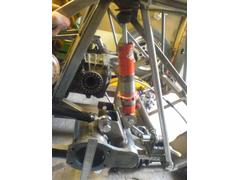MikeR
|
| posted on 26/4/09 at 05:16 PM |

|
|
Shock mounting - away from trailing arms intoducing bending moment, problem?
Ok, I've got a problem with my de-dion install covered elsewhere. the simple solution is to move the shock mount.
Normally the shock mount is in-line with the trailing arm mounts on the de-dion / live axle. So any upwards motion goes upwards.
I want to move the shock mount an inch or two rearwards and downwards. I understand this will give me falling rate on the shock and am willing to
accept this).
I think this means if the car goes over the bump. The spring that's stopping the bump is mounted two inches behind the trailing arms, so the axle
will try and rotate around the spring point. This will mean the trailing arms (1/2 rose joint & 7/16ths poly bush) will have to contain the
twisting force.
do you think this will be a problem in principle?
 
revised shock mount
|
|
|
|
|
dmac
|
| posted on 26/4/09 at 07:47 PM |

|
|
If I understand what you are saying then the forces will be tension in the top arms and compression in the bottom arms, I don't think that will
cause a problem.
Duncan
|
|
|
MikeR
|
| posted on 27/4/09 at 07:03 AM |

|
|
As I was driving to a mates last night it occured to me its similar to what happens when you go over a speed bump. the trailing arms are trying to
locate the wheel and allow it to go up / down.
When you hit the speed bump it is trying to force the wheel backwards, this is resisted so it has to go up / down.
|
|
|
MikeRJ
|
| posted on 27/4/09 at 08:44 AM |

|
|
The trailing arms have to resist the considerably larger torque in the axle from braking, so I doubt this is going to cause a problem.
BTW it probably won't give a falling rate, check the angle between shock and trailing arms at full bump and rebound. If the angle reduces in
bump, it's falling rate but you usually have to start with quite a small angle to get this. In fact with the rather short trailing arms used on
the locost, you may well find that the shock and trailing arms get closer to 90 degrees at full bump, giving a slightly rising rate.
[Edited on 27/4/09 by MikeRJ]
|
|
|













